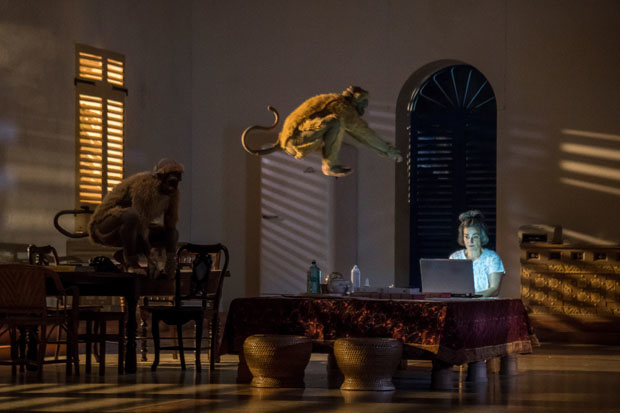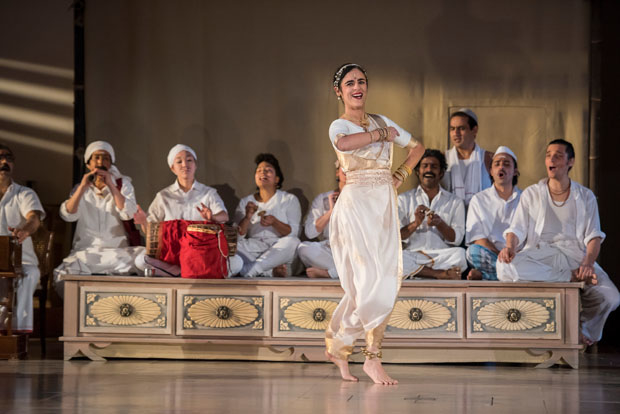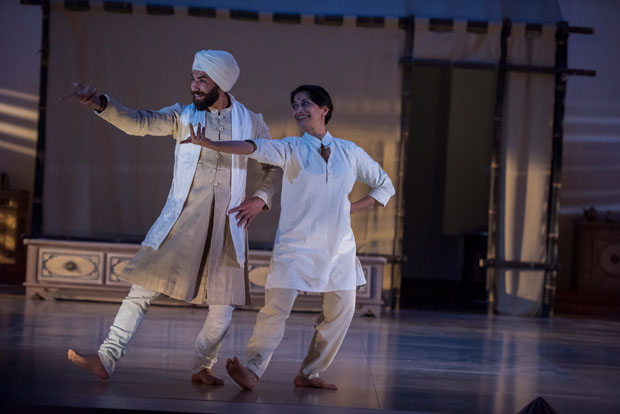A Room in India
The entire globe fits onto the stage of the Park Avenue Armory in Théâtre du Soleil’s latest creation.

(© Stephanie Berger)
True to it's title, this play really does take place entirely in a room in India, complete with ceiling fans whirring overhead as the sun pierces through the window shutters and casts bars of light onto mismatched furniture. Théâtre du Soleil's A Room in India (now playing at Park Avenue Armory) often looks like the set of a stage adaptation of The Best Exotic Marigold Hotel. But the Paris-based company and its indefatigable director, Ariane Mnouchkine, have ambitions for this piece that stretch far beyond the constraints of any one country, time period, or story.
Still, if a play like this is going to be performed anywhere, it might as well be in a room in India, the birthplace of so many cultures and the land in which they all implausibly coexist under the auspices of Earth's largest democracy. This specific room is in Madam Murti's guesthouse and is occupied by Cornélia (the hilarious Hélène Cinque as a kind of French Hannah Horvath). She is the assistant to French experimental theater director Constantin Lear (voiced by Vladimir Ant). His troupe has been brought to India by the Alliance Française, but when Lear goes wandering across the Pondicherry heaths in existential grief over recent terrorist attacks in Paris, he leaves Cornélia is charge.

(© Stephanie Berger)
Much of what we see onstage springs from her anxiety-ridden dreams as she struggles to create something timely and profound to fulfill the troupe's commission. "Don't do the Mahabharata," Lear warns her in his farewell message, "it will crush you." He's the kind of messianic auteur that Théâtre du Soleil has long eschewed, which is why this militantly collaborative company includes several thrilling scenes from that Sanskrit epic, performed here as Therukoothu (an ancient form of Tamil theater). Choreographed by Kalaimamani Purisai Kannappa Sambandan Thambiran, these exhilarating passages are performed in Tamil, with the entire ensemble acting as backup musicians.
Other scenes are performed in French, English, Russian, and Arabic. There are allusions to Shakespeare, Noh, and Chekhov, making A Room in India feel like a family meeting of the world’s theatrical traditions, gathered to discuss Syria, terrorism, resurgent nationalism, the abuse of women, and environmental degradation. Théâtre du Soleil is decisively indecisive about which of these subjects should take precedence, and that is as it should be: When the world seems to be unraveling, they're all important.
What is consistent is how the company brings an undeniably French spirit to the stage, unbound by political correctness and unashamed of liberalism. Scenes lampooning Islamic State and the Saudi "Committee for Human Rights" combat authoritarianism with much-needed mockery.
Théâtre du Soleil is also refreshingly unembarrassed to be a theater. The first thing we see as we step into the drill hall is the communal dressing room, tucked under the risers yet completely visible. This disarming openness immediately helps build a community with the actors, which is important considering we'll be spending the next four hours with them (this play is admittedly a commitment, but it feels like a breeze compared to Les Éphémères, the company's 2009 production at the Armory that was twice as long).

(© Stephanie Berger)
The design is also devised communally, with several hands at work creating the expansive set, the heroically wide-ranging costume plot, the intense lighting, and evocative sound, which suggests a restive Indian town just outside the room's walls. The eclectic, ever-present, and mood-defining music is by Jean-Jacques Lemêtre, while playwright Hélène Cixous brings harmony to the collaboratively created script.
Though there were several memorable performances, here are just a few of my favorites: Madam Murti (the quietly powerful Nirupama Nityanandan) and her long-lost love (the charming Seear Kohi) perform a joyous and heartbreaking dance. A Japanese King Lear (Seietsu Onochi sporting a mask-like face) defiantly stabs a B.J.P. bully (the effortlessly nasty Duccio Bellugi-Vannuccini) with his samurai sword. Draupadi (the emotional and vocally adroit Judit Janscó) beseeches the aid of the God Krishna (a stoic Palani Murugan)…and he delivers!

(© Stephanie Berger)
Detractors will complain that A Room in India is too unfocused and that its sprawling elements never congeal into a cohesive whole. But isn't such thematic clarity one of the theater’s greatest lies? In A Room in India, Théâtre du Soleil has created a play that is as messy, chaotic, and unpredictable as the real world.








